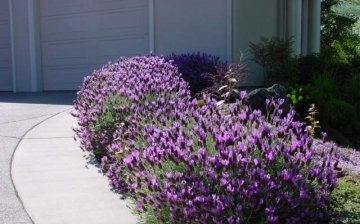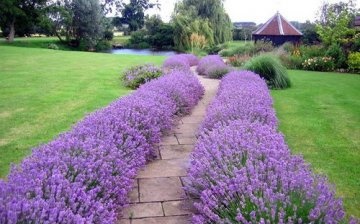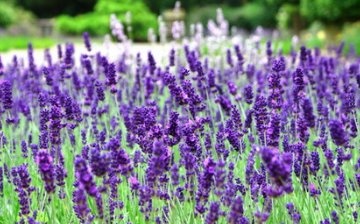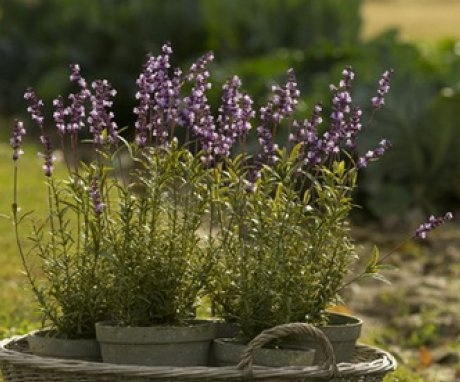How to grow lavender in your country house
A modest appearance, with small delicate flowers of a violet-blue color, lavender has been known to mankind for a very long time. The peoples of Southern Europe, considered the birthplace of this flower, added it to wine as a flavoring and natural preservative. The famous healers of antiquity believed that this miraculous flower can protect from many different misfortunes and even from the spread of epidemics. The very name of lavender comes from the Latin "lavare" (to wash, clean).
Content:
- The healing properties of lavender
- Types of lavender
- Reproduction of lavender in the open field
- Lavender in the garden: site illumination
- Soil requirements
- Lavender care
- Growing lavender indoors
The healing properties of lavender
Lavender has rightfully won the proud title of the queen of aromatherapy. This plant contains a wide variety of essential oils that can have a calming effect on the human nervous system. In order to create a unique atmosphere in your own home and bring harmony to it, dried lavender flowers are used for interior decoration and even as a filler for pillows.
In medicine, the plant is used for the preparation of tinctures or in dried form. Healing qualities lavender due to a number of acids contained mainly in the flowers of the plant and helping to improve blood circulation. It is impossible not to mention the excellent antiseptic properties, as well as insecticidal, repelling moths and midges.
Types of lavender
Lavender is considered a fairly unpretentious plant, care behind it is simple. You just need to adhere to the basic rules of its cultivation. Lavender is conventionally divided into 2 types: French broadleaf and English narrow-leaved... Only English lavender can be grown outdoors in a climate in the middle zone.
Reproduction of lavender in the open field
For plant propagation, the best way is grafting... In early summer, cuttings are planted shallowly in loose soil and covered with a film. With regular watering, rooting occurs fairly quickly.
Another method of planting a plant is propagation by layering. To obtain layering, the lower branches of the bush are folded back, sprinkled with earth at the point of contact with the ground and fixed. This procedure is done in the spring. The branches take root soon. The resulting layers are carefully cut off from the bush, not forgetting to treat the cut with coal.
You can propagate lavender by simply dividing a healthy bush into several parts. To do this, in the fall, the bush is cut and sprinkled, and in the spring it will give many new shoots.
Lavender in the garden: site illumination
In order to grow lavender in your summer cottage, you will have to remember that this evergreen essential oil shrub grows wild in the Mediterranean mountains. Therefore, you need to choose the most illuminated, sunny places for growing immediately, in which water does not stagnate - lavender does not tolerate transplanting well. In the shade, lavender will also grow, but it will not be possible to achieve a lush color.
Soil requirements
The soil for planting a crop should be porous, therefore, the introduction of compost to the garden bed, which helps to loosen the soil, must be carried out regularly. In terms of acidity, the soil should be slightly acidic, alkaline or neutral.To deoxidize the soil, before planting the plant, it is worth adding wood ash or lime (you can in the form of crushed eggshell).
Lavender is very critical of waterlogging the soil, so you need to water it as the soil near the trunk dries up. Otherwise, the roots of the plant will begin to rot and the leaves will turn yellow.
To ensure constant air penetration to the roots, lavender beds are mulched with humus, leaving the soil near the base of the bush open. If there is excess moisture near the roots, a drainage layer will definitely be needed.
Lavender care
- In order for lavender bushes to create a dense lush hedge, they are planted at a distance of half the maximum plant height (depending on the specific variety and ranges from 0.5 m to 1.5 m). For a beautiful design of flower beds, the intervals between plants are doubled.
- To maintain decorativeness, it is advisable to cut lavender bushes, shortening them by a couple of cm at the end of flowering. At the end of the season, the plant is pruned again.
- In early summer, to enhance the growth of green mass, lavender needs nitrogen fertilizers. They have not been used since mid-summer. When mulching with compost throughout the summer, fertilizers can be completely abandoned.
- In winter with little snow, especially when the temperature drops below 25 degrees below zero, lavender bushes can die in the open field. Therefore, in the fall, it is better to insulate the beds with lavender with branches of coniferous trees.
Growing lavender indoors
French lavender is also suitable for indoor cultivation. You can plant its seeds in a small pot with a volume of up to 2 liters. Line the bottom of the pot with drainage and cover with light alkaline soil.
Pre-soak the seeds in a mixture of sawdust and sand at a temperature of about 5 degrees (in the refrigerator) for 1.5 months. A pot with shallow-planted seeds is placed in a bright place, and shoots should appear in a month. If there is not enough natural light, artificial lighting should be used. By planting seeds in November, you can get grown seedlings by spring. As soon as they are strong enough, you can begin to take them out to the balcony, protecting them from the wind.
Knowing these simple secrets, you can get wonderful flowers on your windowsill or in the garden, about which there are many legends. According to one of them, the Virgin Mary gave a wonderful aroma to a modest flower for drying the clothes of the baby Jesus on a bush of a plant.
People say that the presence of lavender in the house helps to attract good and light forces, and the flower itself personifies happiness and spirituality.














For some reason I can't grow lavender in the country. Apparently, I cannot create the same conditions as in the mountains.